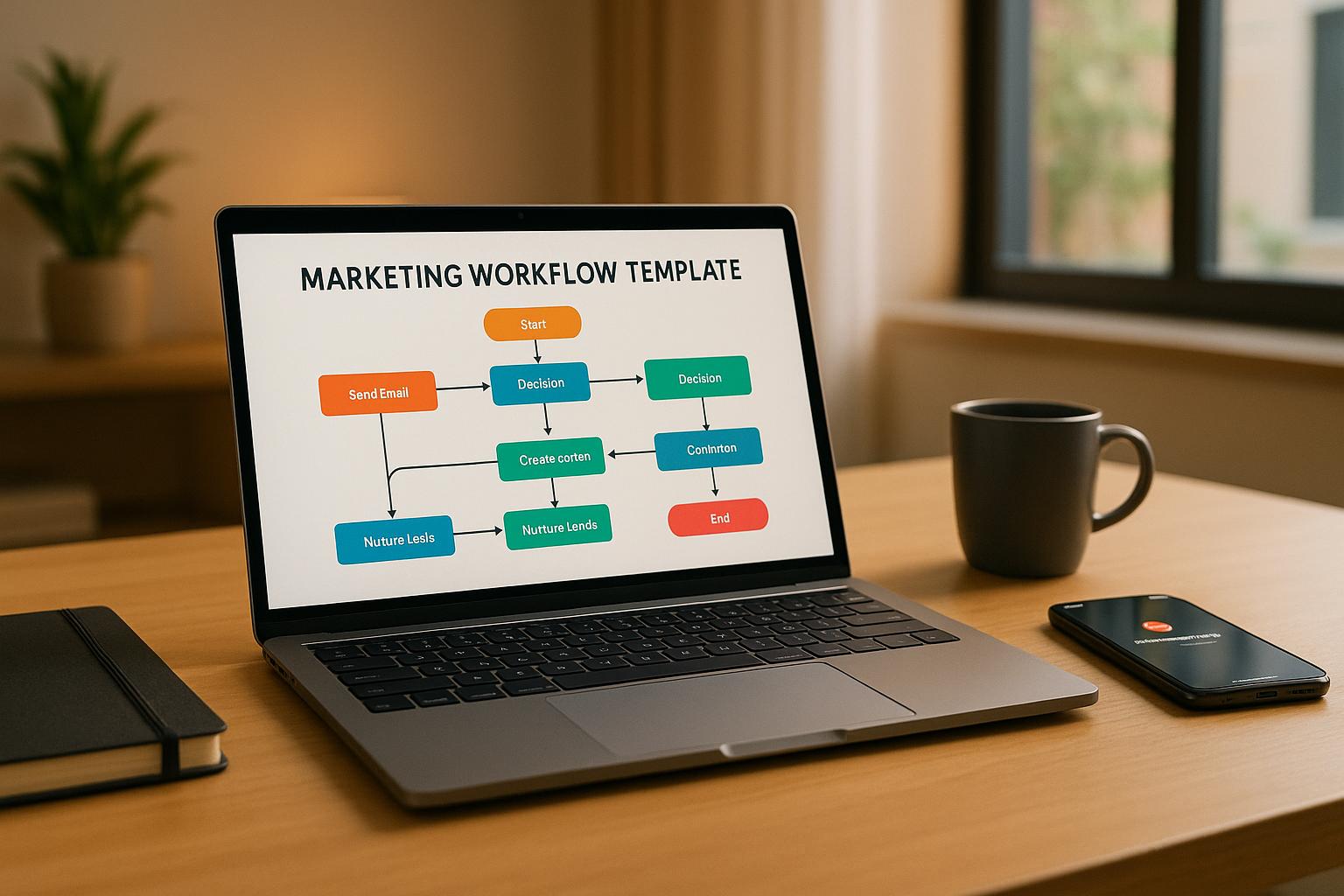Want to sell properties faster and attract buyers online? Social media marketing is essential, with 97% of buyers searching online and platforms like Facebook, Instagram, and LinkedIn driving engagement. Here’s a quick checklist to boost your property listings:
- High-Quality Visuals: Use professional photos, videos, and virtual tours (like 3D walkthroughs) to showcase properties.
- Platform-Specific Tips:
- Facebook: Use carousel posts, lead ads, and video tours for better engagement.
- Instagram: Post visually appealing content with Stories, Reels, and location tags.
- LinkedIn: Target luxury buyers and investors with market insights and professional posts.
- Content Strategy: Share property showcases, market updates, and local community highlights.
- Engagement: Respond to comments, leverage client reviews, and build local connections.
- Track Results: Use tools like Facebook Pixel and Google Analytics to measure engagement and improve campaigns.
Pro Tip: Listings with professional visuals sell 32% faster, and virtual tours can drive offers without in-person visits. Ready to optimize your strategy? Let’s dive in.
Social Media Post Ideas For Real Estate Listings
Property Content Setup
Creating standout listings in a crowded market starts with well-crafted, professional content.
Photos and Videos
High-quality visuals are non-negotiable in real estate today. Here’s how to make your listings shine:
| Content Type | Requirements |
|---|---|
| Photos | High-resolution images with wide-angle views |
| Video Tours | Clear, stabilized footage of an engaging length |
| Reels/Stories | Vertical format, quickly showcasing key features |
| Drone Footage | Aerial shots highlighting the property and area |
Hiring professional photographers and videographers can elevate your listing and attract more attention.
Virtual Tours and 3D Views
Virtual experiences are becoming a must-have for property listings. Include options like:
- 3D Walkthroughs: Platforms like Matterport or iGuide offer immersive tours that let viewers explore the space.
- 360° Room Views: Interactive views created with specialized cameras.
- Floor Plans: Provide both 2D layouts and interactive 3D versions.
- Measurement Tools: Help potential buyers assess room dimensions.
Property Descriptions
A well-written property description grabs attention and provides essential details:
Opening Hook
Start with the property’s standout feature in a way that’s short and shareable.
Key Features
Present the most important details in a clear format, such as:
- Highlights of the location
- Recent renovations or upgrades
- Unique aspects of the property
- Features like smart home systems or energy-efficient elements
Call to Action
Encourage potential buyers to book a viewing or ask for more information.
Property Information
A detailed property information sheet can answer buyers’ questions upfront. Include:
| Category | Details to Include |
|---|---|
| Basic Info | Price, square footage, number of bedrooms and bathrooms |
| Technical Details | Year built, lot size, type of heating and cooling systems |
| Financial Data | Property taxes, HOA fees, average utility costs |
| Location Details | School districts, walkability, nearby amenities |
| Special Features | Smart home tech, eco-friendly updates, unique upgrades |
Social Media Platform Setup
Each social media platform has its own style and approach for showcasing property listings effectively.
Facebook Best Practices
Facebook offers a variety of tools that are perfect for marketing properties. Here are some tips to make the most of its features:
| Feature | Best Practice | Impact |
|---|---|---|
| Carousel Posts | Include 5–10 high-quality photos to showcase property features | Increases visual appeal and interest |
| Lead Ads | Provide exclusive property lists or market insights | Helps generate a large number of leads |
| Video Content | Share 360° virtual tours and property walkthroughs | Drives more inquiries significantly |
"Facebook aims to minimize click costs. Nonetheless, leads objective campaigns across industries are showing a 66% higher CTR compared to traffic objective ad campaigns".
Instagram, on the other hand, relies heavily on visual storytelling to capture attention.
Instagram Best Practices
Feed Strategy
- Post 3–5 times during peak engagement hours.
- Keep a consistent visual style and branding.
- Use location tags to boost discoverability.
Story Features
- Create consecutive Stories for virtual tours.
- Use interactive tools like polls to engage viewers.
- Save key Stories in property Highlights for ongoing visibility.
Did you know? Posts with video on social media get 48% more views. Many agents also use Instagram Highlights to showcase high-quality photos and include swipe-up links for calls to action.
For a professional audience, LinkedIn provides a more targeted way to connect with high-value prospects.
LinkedIn Best Practices
Profile Optimization
- Use a professional headshot and a branded cover photo.
- Highlight your services and specializations.
- Include client recommendations to build credibility.
Content Strategy
- Share insights like market analysis.
- Post videos, which get five times more engagement.
- Create "how-to" posts for a 31.5% boost in performance.
LinkedIn boasts a 2.74% visitor-to-lead conversion rate, making it especially effective for marketing luxury and commercial properties. Plus, video content is 20 times more likely to be shared on LinkedIn.
Keep a close eye on your analytics to fine-tune your strategy and plan content that resonates with your audience.
sbb-itb-2f9da9d
Content Planning
A solid content plan ensures your social media marketing stays consistent and engaging. It builds on your professional content setup, making sure every post boosts property visibility.
Post Schedule
Sticking to a regular posting schedule helps keep your audience connected. Did you know 77% of realtors use social media to engage with clients and promote properties?
Here’s a handy weekly content rotation using the M.E.A.L.L. framework:
| Day | Content Type | Example Post |
|---|---|---|
| Monday | Market Updates | Local housing market statistics |
| Tuesday | Events | Open house announcements |
| Wednesday | Advice | Home buying tips |
| Thursday | Local News | Community development updates |
| Friday | Listings | Featured property showcase |
Content Mix
With 99% of millennials starting their home search online, it’s important to balance educational, promotional, and interactive content to keep your audience interested.
Main Content Categories:
-
Property Showcases
Share virtual tours, 360° views, before-and-after transformation photos, neighborhood highlights, and professional staging images. -
Educational Content
Provide insights like market trends, mortgage rate updates, home maintenance tips, and guides for first-time buyers. -
Community Connection
Highlight local businesses, share school district updates, promote upcoming community events, and create neighborhood guides.
Automation Tools
Social media management can be easier with automation tools, helping you stay consistent without sacrificing a personal touch. Here are some highly rated options:
| Tool | Best For | Key Features |
|---|---|---|
| Hootsuite | Comprehensive Management | Multi-platform scheduling, analytics, team collaboration |
| Facebook Business Suite | Facebook/Instagram Focus | Basic scheduling, insights, ad management |
| Curated Social | Ready-made Content | Industry-specific templates, automated posting |
"Curated Social does an excellent job with providing fresh weekly content and makes life so much easier! I spent forever on social media before this." – Kyle Weston, Real Estate Agent
These strategies lay the groundwork for creating stronger audience connections, setting you up for success in the next steps.
Audience Engagement
With 95% of buyers checking online reviews, it’s essential to engage potential buyers thoughtfully to build strong, lasting connections.
Comment Management
Effectively managing comments can enhance your online presence and reputation. Here’s how to handle different types of responses:
| Response Type | Best Practice | Example Response |
|---|---|---|
| Property Questions | Respond publicly first, then move to DM | "Great question about the square footage! It’s 2,400 sq ft. I’ll DM you the full floor plan." |
| Price Inquiries | Acknowledge publicly, discuss privately | "Thanks for your interest! Let’s discuss pricing details in a private message." |
| Negative Comments | Stay professional and use facts | "We appreciate your feedback. Our listing prices reflect current market values. Happy to discuss this further." |
Quick, professional responses not only address concerns but also help you connect with the local community, boosting engagement further.
Local Network Building
Once you’ve tackled comment management, focus on creating a strong presence within your local network.
Ways to Connect Locally:
- Collaborate with nearby businesses and share neighborhood insights.
- Highlight updates in the community that could influence property values.
- Join and participate in local Facebook groups and online discussions.
"Real estate networking is the process of building and nurturing professional relationships within the industry and the broader community to generate business opportunities, share knowledge, and provide mutual support." – Luxury Presence
Client Reviews
Since 88% of consumers trust online reviews as much as personal recommendations, showcasing client testimonials can be a game-changer.
Tips for Generating Reviews:
- Add QR codes to property flyers or materials for easy review submissions.
- Send personalized review requests after completing transactions.
- Share glowing testimonials on your social media platforms.
- Respond to all reviews promptly and professionally.
"To increase positive reviews for your business, inform and educate your customers on how important reviews are to your business. The customers who want to support you will show their support in the form of positive reviews." – Luke Wester, Miva
Results Measurement
Once you’ve created content and engaged your audience, it’s time to measure how it’s performing. This step helps you figure out what’s working and what needs tweaking.
Tracking Setup
Here’s how to set up the tools you need to track performance:
Facebook Pixel Setup
- Log into Facebook Ads Manager, then go to Tools → Pixels.
- Place the pixel code in your website’s
<head></head>section. - Use the Facebook Pixel Helper Chrome extension to confirm everything is installed correctly.
- Build custom audiences by analyzing how visitors interact with your site.
Google Analytics 4 (GA4) Implementation
- Create a GA4 property using Google’s Setup Assistant.
- Adjust data-sharing settings to ensure you’re capturing all necessary information.
- Add UTM parameters to your social media links with Google’s Campaign URL Builder.
- Link GA4 to your social media management platform for streamlined reporting.
Performance Metrics
Keep an eye on these key metrics to understand how your content is doing:
| Metric Type | What to Track |
|---|---|
| Engagement | Post likes, shares, and comments |
| Traffic | Click-through rates and website visits |
| Leads | Form submissions and inquiries |
| Reach | Impressions and audience growth |
"Every social post has a different goal and purpose. While some were created for awareness, others were created to convert. Make sure to note that down so your team knows what metrics they should be monitoring."
– Eileen Kwok, Social and Influencer Marketing Strategist, Hootsuite
Reviewing these metrics will help you spot what’s working well and where there’s room for improvement.
Data-Based Improvements
Use the insights from your tracking tools to sharpen your approach:
Content Optimization
- Study your best-performing posts to figure out what resonates with your audience.
- Adjust your posting schedule to match peak engagement times.
- Experiment with photo angles and video formats to see what grabs attention.
Audience Targeting
- Create custom and lookalike audiences based on user interactions and conversions.
- Fine-tune targeting by analyzing demographic data.
"With a Google Analytics dashboard, you can share the success of the conversions you’ve been able to bring to the organization."
– Eileen Kwok, Social and Influencer Marketing Strategist, Hootsuite
A/B Testing Framework
- Test different property headlines.
- Experiment with call-to-action phrases.
- Compare the impact of varying image counts in your listings.
Summary
In 2022, 38% of new real estate clients came through social media, and 46% of Realtors identified it as their top source for high-quality leads. This checklist is designed to help real estate professionals effectively showcase property listings online.
Key Elements for Success:
| Component | Impact |
|---|---|
| Professional Visuals | Listings with professional photos sell 32% faster. |
| Virtual Tours | 63% of buyers made offers without in-person visits in 2020. |
| Platform Presence | 89% of agents use Facebook, 59% Instagram, and 53% LinkedIn. |
| Content Strategy | 96% of home buyers rely on online tools during their search. |
Expert advice highlights the importance of personalization in real estate marketing. As CubiCasa explains:
"Identifying your target audience is crucial in real estate marketing. Tailor your strategy, build a unique brand identity, and engage effectively".
This tailored approach is essential for everything from creating content to tracking performance.
With the average person spending 2.5 hours daily across six platforms, maintaining an active and engaging presence is key. By using this checklist to guide your content planning, audience interaction, and performance evaluation, real estate professionals can tap into the vast opportunities social media offers.
Consistency and data-driven adjustments are critical for success. Companies that track performance data have reported 20-30% improvements in marketing efficiency. Regularly reviewing metrics and refining strategies based on real results ensures your property listings gain maximum visibility and engagement.
This checklist provides a clear path to harnessing social media’s power in real estate, helping you transform online views into tangible sales.



